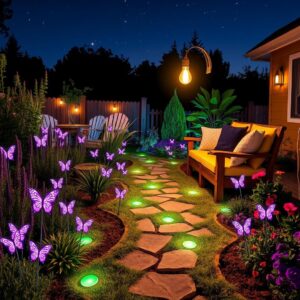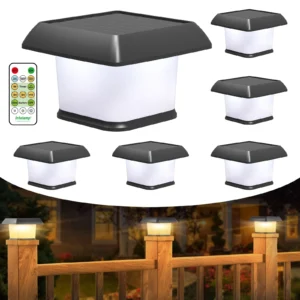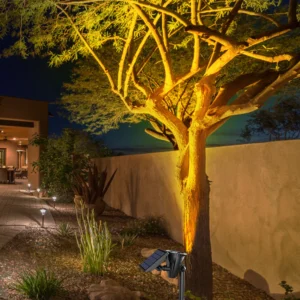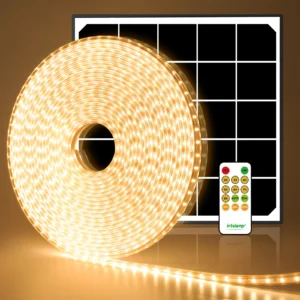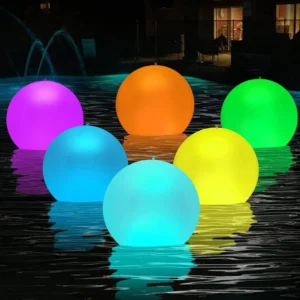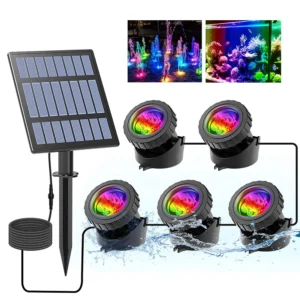Solar fountains are a stunning addition to any garden, offering both aesthetic appeal and practical advantages. They provide a soothing ambiance with the sound of flowing water, attract wildlife, and enhance the overall outdoor experience.
Understanding Fountain Pumps
Fountain pumps are essential components that circulate water in both traditional and solar-powered fountains. Traditional fountain pumps rely on electricity from a power source, which powers a motor that propels water through the fountain system. This setup usually involves connecting the pump to an electrical outlet, making it a straightforward yet energy-dependent solution. While these pumps can provide strong water flow and consistent performance, they also lead to higher energy costs and limit placement options, as they must be near a power source.
In contrast, solar fountain pumps operate using solar panels that convert sunlight into electricity. These panels are typically mounted on the fountain itself or nearby, collecting solar energy during the day. This energy is used to power the pump, making solar fountains more versatile and eco-friendly. They can be placed in various locations without the need for electrical wiring, allowing for creative landscaping designs.
However, the performance of solar pumps can vary based on sunlight availability. On sunny days, they can operate efficiently, while cloudy or shaded conditions may reduce their effectiveness. Some advanced solar fountains come with battery backup systems, enabling them to store energy collected during the day for use at night or during low-light conditions. This feature enhances their usability, providing a more reliable water flow even when the sun isn’t shining.
Are Solar Fountains Effective?
Solar fountains are increasingly popular due to their eco-friendly design and ease of use, but their effectiveness can vary based on several factors, including performance considerations and garden size suitability.
Performance Considerations
The performance of a solar fountain largely depends on its size, the efficiency of its solar panels, and the availability of sunlight. Smaller solar fountains tend to work better in direct sunlight, as they require less power to operate. These compact models are ideal for smaller gardens, patios, or balconies where space is limited. However, they may not produce as much water flow or visual impact as larger fountains.
Larger solar fountains can create a stunning focal point in more expansive gardens, but they typically require more sunlight to function optimally. If placed in an area with consistent sun exposure, these larger units can provide significant water flow, enhancing the overall aesthetic and calming atmosphere of the outdoor space. It’s essential to consider the wattage of the solar panels and the power consumption of the pump when selecting a solar fountain. Higher wattage generally means better performance, especially in larger installations.
Additionally, some solar fountains come with advanced features, such as adjustable flow rates or multiple spray patterns, allowing users to customize the water display. These features can enhance the visual appeal and create different moods in the garden, making them more versatile.
Suitability for Different Garden Sizes
When choosing a solar fountain, it’s crucial to match its size and capacity to the garden space. For small gardens or confined areas, a compact solar fountain can provide beauty and tranquility without overwhelming the landscape. These smaller models can be placed on tabletops or within flower beds, adding charm without taking up much space.
In contrast, larger gardens benefit from bigger solar fountains that can serve as stunning centerpieces. These fountains can draw attention and create a sense of grandeur, making them suitable for open areas where they can be easily viewed from multiple angles. However, it’s important to ensure that larger fountains are positioned in well-lit spots to maximize their performance.
Operational Hours of Solar Fountains
Understanding the operational hours of solar fountains is essential for maximizing their functionality and aesthetic appeal. These fountains are designed to harness solar energy, which directly influences when and how they operate.
Daytime Functionality
Solar fountains typically function during the day when sunlight is abundant. The solar panels convert sunlight into electricity, powering the pump that circulates water. In ideal conditions, where the fountain is placed in full sun, it can produce a steady flow of water, creating a calming ambiance and attracting birds and other wildlife. The efficiency of solar panels varies, but most are optimized to operate effectively during peak sunlight hours. It’s important to position the fountain in a location that receives unobstructed sunlight for the best performance.
During cloudy or overcast days, the water flow may decrease as the solar panels generate less electricity. However, many solar fountains can still operate under these conditions, albeit at reduced efficiency. Gardeners should consider the local climate and sunlight patterns when selecting a solar fountain to ensure that it meets their expectations for daily operation.
Night Operation with Battery Backup
One of the limitations of traditional solar fountains is their reliance on sunlight, which means they typically do not operate at night. However, many modern solar fountains come equipped with battery backup systems that allow them to run after sunset. These batteries store energy generated during the day, enabling the fountain to continue operating when natural light fades.
The capacity of the battery determines how long the fountain can run at night. Some systems may provide a few hours of operation after dark, while others can sustain functionality for longer periods. This feature is particularly beneficial for those who enjoy outdoor gatherings or want to maintain the fountain’s aesthetic appeal during the evening.
Lighting Options
In addition to nighttime operation, many solar fountains also incorporate lighting features. These lights are usually powered by a separate solar panel system or integrated with the fountain itself. They can illuminate the fountain, creating a magical atmosphere in the garden after dark. LED lights are commonly used due to their energy efficiency and longevity, allowing for vibrant displays without draining the battery too quickly.
Some solar fountains feature programmable lighting options, enabling users to set specific times for the lights to turn on and off. This adds an extra layer of customization, enhancing the garden’s ambiance and highlighting the fountain’s beauty in the evenings.
Overall, understanding the operational hours of solar fountains, including their daytime functionality, battery backup for nighttime use, and lighting options, is crucial for making the most of this enchanting garden feature. By selecting the right model and optimizing placement, homeowners can enjoy the beauty and serenity of solar fountains around the clock.
Sunlight Requirements for Optimal Performance
Sunlight is the lifeblood of solar fountains, directly influencing their functionality and overall performance. Understanding the specific sunlight requirements can help homeowners choose the right model and ensure optimal operation.
Direct Sunlight Needs
Solar fountains are designed to harness solar energy through photovoltaic panels, which convert sunlight into electricity. For optimal performance, these panels need direct sunlight for a significant portion of the day. Most solar fountains perform best when placed in areas that receive at least six to eight hours of direct sunlight daily. This consistent exposure allows the solar panels to generate sufficient power to operate the pump effectively, ensuring a steady flow of water.
When installing a solar fountain, it’s important to avoid shaded areas created by trees, buildings, or other structures. Even partial shade can drastically reduce the amount of electricity generated, leading to diminished water flow or complete inactivity. To achieve the best results, gardeners should consider factors such as the position of the sun throughout the day and the seasonal variations in sunlight.
Performance in Cloudy Conditions
While solar fountains are primarily designed to operate in sunlight, many models can still function, albeit at reduced efficiency, during cloudy or overcast days. In these conditions, the solar panels receive less light, which can result in a decrease in the power generated. This may cause the fountain’s pump to operate at a lower flow rate or intermittently, depending on the amount of available light.
Some solar fountains are equipped with larger or more efficient solar panels, which can help mitigate the effects of cloudy weather. Additionally, models with integrated battery backup systems can store energy generated during sunnier periods, allowing for continued operation during less favorable conditions. This capability provides added reliability, ensuring that the fountain can still run for a limited time on cloudy days or in the shade.
However, it’s essential to manage expectations regarding performance during prolonged periods of overcast weather. In regions with frequent cloudy days, homeowners might consider supplementary solutions, such as positioning the fountain in the sunniest part of the garden or selecting a model known for better performance under variable light conditions.
Charging Time and Lifespan of Solar Fountains
The charging time and lifespan of solar fountains are critical aspects that influence their efficiency and longevity. Understanding the factors that affect these elements can help homeowners make informed choices and ensure optimal performance.
Factors Affecting Charging Time
The charging time for solar fountains depends on several key factors, including the size and efficiency of the solar panels, the battery capacity, and the amount of sunlight available.
Size and Efficiency of Solar Panels: Larger solar panels typically have a greater surface area to capture sunlight, which can lead to quicker charging times. Additionally, more efficient panels convert sunlight into electricity at a higher rate, reducing the time required to fully charge the battery. Homeowners should look for models with high-quality solar panels, as these will perform better under varying sunlight conditions.
Battery Capacity: The size of the battery plays a significant role in charging time. A larger battery can store more energy but may take longer to charge fully compared to a smaller battery. Conversely, a small battery may charge quickly but might not provide enough power for extended operation. The balance between panel size and battery capacity is crucial for optimal performance.
Sunlight Availability: The amount of direct sunlight the solar panels receive directly impacts charging efficiency. On sunny days, it may take around 6 to 8 hours for a fountain to charge fully, while cloudy days or partial shade can extend this time considerably. Homeowners should monitor local weather conditions and position their fountains in areas that receive maximum sunlight to ensure timely charging.
Overall Durability
The durability and lifespan of a solar fountain are influenced by the quality of materials, maintenance practices, and environmental factors.
Quality of Materials: Solar fountains made from high-quality, weather-resistant materials are more likely to endure the elements and have a longer lifespan. Components like the pump, solar panels, and battery should be designed to withstand exposure to water, sunlight, and temperature fluctuations. Investing in a well-constructed fountain can lead to years of reliable performance.
Maintenance Practices: Regular maintenance is essential for prolonging the life of solar fountains. Cleaning the solar panels to remove dirt, debris, or algae ensures they can absorb sunlight effectively. Additionally, periodic inspection of the pump and battery can help identify potential issues before they become serious problems. Maintaining proper water levels and preventing clogging also contribute to the fountain’s longevity.
Environmental Factors: The local climate and environmental conditions play a significant role in determining how long a solar fountain lasts. Areas with extreme temperatures, heavy rainfall, or harsh UV exposure can cause wear and tear on the fountain’s components. Homeowners should consider these factors when selecting a location for their fountain and may need to take protective measures during severe weather.
Conclusion
A solar fountain is an elegant, eco-friendly solution to elevate your outdoor space. By harnessing solar energy, these fountains require minimal maintenance and provide a cost-effective way to enhance your garden’s atmosphere. With the right selection, a solar fountain can become a beautiful focal point, offering tranquility and charm to your home.
By focusing on keywords like “solar fountain benefits,” “how solar fountains work,” and “best solar fountains,” you can improve your blog’s visibility and attract more readers interested in enhancing their gardens with sustainable options.


